Nocturnal Dialogues #4: Nature at Night
*This event, which was to take place on 13 June, has been rescheduled to 18 September
- Date
- 18 September 2024
- Time
- 19:00 -21:00
- Location
- BG 3
- Room
- VOX-POP

Hannah is an ecologist passionate about nature. Her work is centered on the conservation of ecosystems and understanding the intricate ways in which human activities impact biodiversity. Currently, as part of her doctoral research at the University of Amsterdam, she investigates the effect of light pollution on the food web.
Hannah will lead the night walk, guiding us through the hidden habitats of various species in the center of Amsterdam. Using bat detectors and light traps, we’ll explore the effects of light pollution on these species, uncovering how they adapt and survive in the urban night.

Tom van den Hoven (1994) is a writer, spoken word artist, and physics teacher. Looking for a way to give voice to his curiosity and amazement he stepped up onto a podium and now gladly shares his insights and teachings. He skillfully combines his knowledge of science and his talent for writing to inspire the audience and perhaps teach them something as well.

Nocturnal Dialogues
The night is often associated with club culture and electronic dance music. With her programme series “Nocturnal Dialogues”, student-in-residence Alina seeks to redefine the boundaries of the urban night. Beyond the beats of nightlife, we explore topics like nature, rituals, and activism at night. We broaden the discussion about who has a right to the city at night, and bring together various academic disciplines engaging with night studies as well as diverse night communities. Students and scholars from fields as diverse as philosophy, urban geography, sociology or music studies can expect to find relevant links with this intersectional programme. This program, spanning across 2024, transcends the stereotypical associations of the night with leisure and economics. Through interactive lectures, workshops or film screenings, we aim to broaden the discussion and include a diverse audience in conversations about the city at night. During this fourth edition we will dedicate our attention to the non-human inhabitants of the city: looking at nocturnal animals and their role in the ecosystem, the housing structures in the city and addressing light pollution effects on the biotope.

Alina Tomescu
Alina has always been passionate about cities and the way that culture contributes to their development. She worked for 7 years on various projects related to heritage and cultural programming in relation to regional and local development. In 2021 she went back to university to focus on exploring academically what the city at night means, and how night studies can enhance her practice until that moment. She noticed that she and several of her friends would feel more comfortable during the night, and that the city opens itself up for different uses during the dark hours. She dived into this topic first through a pre-masters in Cultural Sociology at Erasmus Rotterdam, and then through a more humanities-focused master's programme at the UVA in Comparative Cultural Analysis.
